
April 6th – 30th
NICOLA COADY, ANNE EDWARDS, CHRIS BARKER-GALLOWAY, ROBIN GURR, ROBERT LINIGEN, BILL SAMUELS and GEOFF THOMAS
Gang Gang Gallery is thrilled to be hosting our third collection of ceramic works by a number of talented potters, pushing boundaries with function and form in this energetic and creative exhibition.
OPENING EVENT – Saturday April 8th from 3pm
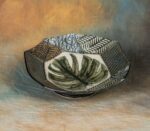
NICOLA COADY
“From the rolling hills of Devon, the vdst veldt of Africa to the weathered shores of Australia, my forms have emerged”.
Arriving in Australia in the late 60’s, I was immediately taken by the eroded sandstone foreshores and flora and fauna. Having canoed many times up the River Dart, Devon, England, where I experienced my formative years and walking along the cliff’s collecting primroses and bluebells overlooking the English Channel, I was acutely aware of the beauty of nature.
ln the early 1970’s the opportunity arose for me to get my hands into clay and I never looked back. Once my two sons started School, I enrolled in TAFE at Brookvale and completed a 4 year part time Diploma Course, graduating in 1986. On graduating, I was approached to teach at the Ku-ring-gai Art Centre in Roseville which I did for 27 years which I thoroughly enjoyed.
I have been a member of the Ceramic Study Group since the late 1980’s and in 2010-2014 was President and currently Vice President. 2016-2021 I was President of the Ferry Artists Gallery at Wisemans Ferry, where I still exhibit a range of my latest creations. Over the years I have been invited and exhibited all over Australia and my work has been acknowledged by winning 28 Awards at different times. To name a few, one of the awards was judged by Lloyd Rees in the late 1970’s at the Lane Cove Annual Art Exhibition which, I think, gave me the impetus to keep potting. ln 2015,1 won the 300 grams. Exhibition/Competition at the Mansfield Ceramics Gallery in Darlinghurst, judged by Art Critic, Dr. Christopher Allen. 2018 won the “Bowl” competition held by the Ceramic Study Group,2019 the ‘Animal, Vegetable and Mineral’ competition with a form entitled “Erosion” judged by Barbara Campbell Allen and in 2021 won the “Party theme” competition judged by Malcolm Greenwood . ln 2014, 2017 and 2018 I won one of the categories of the Annual Teapot Exhibition in Sydney. I have had several solo exhibitions, one entitled “Ripples of Time – celebrating 20 years” which was opened by celebrity John Doyle. My work has been purchased for Permanent Collections and Corporate gifts.
ln 2017 one of my Ned Kelly teapots was auctioned at the NSW Parliament House to raise funds for the AMA for the Luke Batty Foundation. 2017 exhibited with Artist Carol Gill entitled “Confluence” at the Art Studios Gallery in Gosford. Last year 2021,l’was invited and exhibited with a group called “Living Textures” at Brush Farm at Eastwood, “Platinum” celebrating the Ferry Artists 20 years in existence, Living Clay Expo. at the Coal Loader, Waverton, 2022″Ephemeral” at the Gang Gang Gallery, Lithgow and finally the North Shore Craft Group’s annual Exhibition in Thornleigh. My love of texture has drawn me to experiment with crystalline glazes, as it has a certain illusiveness and depth which still intrigues me. Mainly working with stoneware or porcelain clay bodies, l’ve recently started incorporating my East meets West, Japanese “Boro” patchwork concept into some of my creations which can also be adorned with the delicate floral motifs of the Australian bush. I usually fire in my electric, gas and sometimes raku kilns and have access to a wood fired kiln in the Wnter months which adds another dimension to the forms and desired aesthetics.
My insignia – the spiral – means ever evolving and so my journey with my love of clay continues
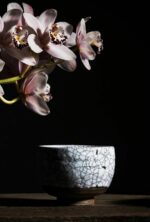
ANNE EDWARDS

CHRIS BARKER-GALLOWAY
”In my ceramics, I work with low temperatures, organic shapes, clear lines and colour, but most of all, I strive for simplicity. Simplicity balances my busy life and my other passion…. portrait sculpture.To quote Edward de Bono…”Simplicity is easy to use but hard to design. Although simplicity is very obvious in hindsight, getting there requires a lot of creative thinking.”

ROBIN GURR
Most of Robin Gurr’s work in this exhibition was inspired by the old Lithgow mine site. She refers to worn graffiti, survivors of fire and detritus from the abandoned mine site. She depicts relics – ” surviving memorials of something past” – and, in so doing, anchors our place in time, contributing to our collective memory by making a material connection with a world which is in the act of slipping away.
Her work consists of wheel formed elements, altered and combined mostly into sculptural vessels, gas fired to stoneware temperatures. Her palate is subdued with surfaces showing evidence of weathering, decay and erosion.
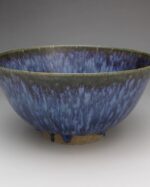
ROBERT LINIGEN
On Making Weed Ash Glazes
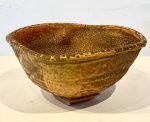
BILL SAMUELS
“….In my own way it exemplifies my approach to the creative process – realizing a whole new technique then solving the problems as they emerge. The idea also evolved out of my approach to ceramic materials in general. While I lean heavily on the traditional approach to ceramics I have deliberately chosen to find and use my own materials rather than commercially prepared ones. THe beauty of some of the old pots from cultures that have a long ceramic history (unlike Oz that has none) has intrigued me for the last 50 odd years. I believe their beauty resulted from the potters use of “materials at hand” and their “primitive” methods of preparation. I don’t mind being called a nutter by my colleagues because I enjoy the chase, the research is endless and it’s what keeps me going, albeit at an increasingly slower pace.”
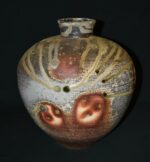
GEOFF THOMAS
The pots for this exhibition are mostly from the fire box area of an anagama kiln where they are exposed to the most severe of the firing conditions. lt is these conditions that give the pots these results. Only 3 to 5 pots fit in this area and the losses are high but as this is the result I am trying to achieve we will keep working on it.
